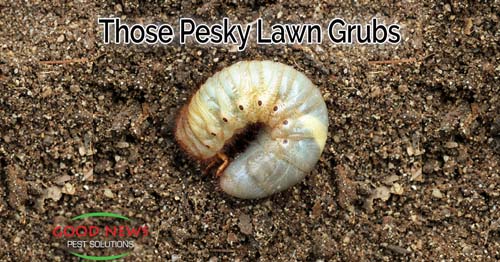
Lawn Grubs - A Fall Pest in Florida
It’s a common experience. You come out of your house during the rainy season after the storm has passed on, only to hear several crunches under your feet. You look down to see June bugs littering your front porch. Well, actually, in Florida, they’re more likely to be Cuban May Beetles than the June Beetles you may have been used to up North.
But did you know, long before they’re staining your sidewalk, the adolescent version of these beetles may be causing unseen damage to your lawn?
The Original Grub Hub
During rainy season, the adult beetles lay eggs in the moist soil. Within a month, the eggs hatch into larvae called white grubs. Those grubs, just like human teenagers, are voracious and are always eating. Unfortunately, their favorite snacks happen to be the roots of our tough Florida grasses.
That means, starting sometime in the fall, you may start to see dead patches of grass in the middle of your yard and some of your plants, especially ornamentals, may start to wilt or die out quickly.
Another sign of white grubs is a visible patch of ripped or torn up grass. Birds often dig the grubs out of your yard. So do raccoons, opossums, skunks and moles. You may have even seen one or more of those critters digging in your yard!
If you’re unsure, you can walk out and gently tug on the brown spots. If there’s grub damage, the patch will pull up easily. Underneath, you might even spot the white, segmented creatures, curled into a C shape with their feet near their head.
Another One Bites the Grass
Unfortunately, once the grubs have started their work, the grass they’ve eaten is no longer viable. The larvae have eaten the roots, so there’s nothing to take hold in the dirt. And if cinch bugs have joined the white grubs, it’s even worse. They secrete a chemical that prevents grass from absorbing water.
That’s one of the reasons for the difficulties we have with even the thick, hardier grasses that we have in Florida. It’s not just because it is fighting to grow in sand. With any luck, you can replace patches of the grass with sod, but in extreme infestations, you’ll need to replant the whole yard – after getting the ground treated, of course.
There IS Good News…
The best way to handle the threat of white grubs and other such yard bugs is to prevent them in the first place. After you’ve been hit, you’ll have to replace the grass, and should consult a lawn professional. GNPS is not licensed to perform treatment for cinch bugs or lawn grubs, but we try to educate home owners about all types of pests in an effort to provide peace of mind - our main goal.
Our customers from Apollo Beach to North Port love the reliability of knowing they don’t have to worry about perimeter pests. If you’d like to learn more, or schedule your first appointment, just give us a call!
Proudly Serving
Sun City Center, Ruskin, Palmetto, Parrish, Ellenton, Bradenton, Anna Maria, Holmes Beach, Bradenton Beach, Longboat Key, Lakewood Ranch, University Park, Myakka City, Sarasota, Siesta Key, Osprey, Nokomis, Casey Key, Venice, Englewood, North Port, Port Charlotte, Punta Gorda, Arcadia
Things You Can Do
Pay Your Bill Online
Leave Us a Review
Request a Free* Termite Inspection
Stop Mosquito Bites
Get Rid of Rodents
Get a Termite Damage Warranty
Get Pest Control for Your Attic
Get Pest Control for Your Business Request Prayer
Corporate Address
1080 Enterprise Court, Ste A
North Venice, FL 34275
Call Now: (941) 412-9610
Text: (941) 412-9610
Fax: (941) 412-0080
